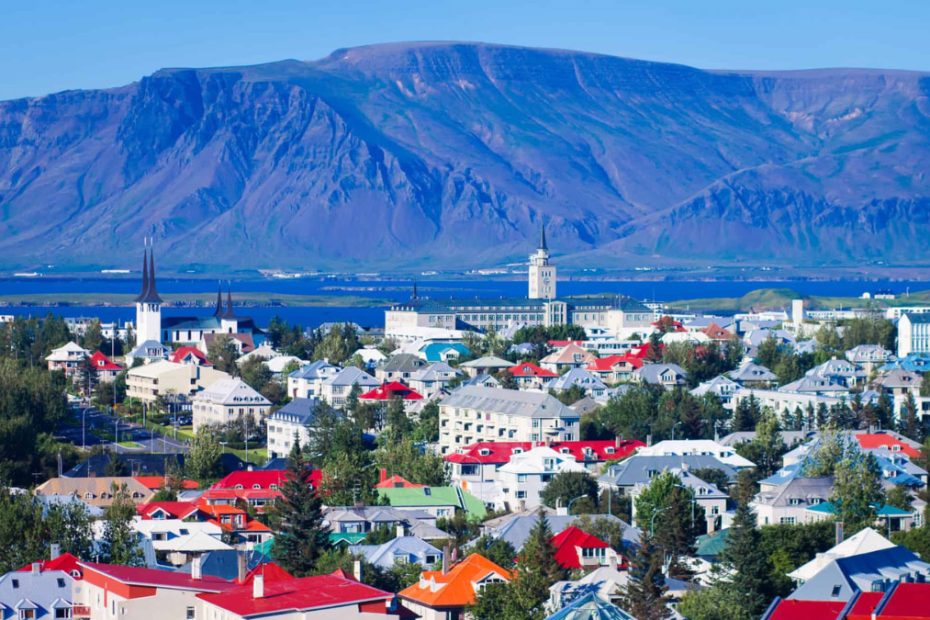Planning a trip to Iceland can be both exhilarating and overwhelming. With its stunning landscapes, geothermal wonders, and unique culture, Iceland offers an adventure that’s hard to match. In just seven days, you can experience the best this Nordic island has to offer, from the bustling streets of Reykjavik to the serene beauty of the Golden Circle.
Key Takeaways
- Diverse Attractions: Iceland offers a mix of vibrant city life in Reykjavik, geothermal wonders like the Blue Lagoon, and natural marvels such as waterfalls and black sand beaches.
- Golden Circle Highlights: Thingvellir National Park, Geysir Geothermal Area, and Gullfoss Waterfall provide a full day of historical and natural beauty in the Golden Circle.
- South Coast Wonders: Key attractions along the South Coast include the iconic Seljalandsfoss and Skógafoss waterfalls and the unique Reynisfjara Black Sand Beach.
- Vatnajokull Adventures: Day 4 features stunning sites like Jokulsarlon Glacier Lagoon, Diamond Beach, and Skaftafell Nature Reserve, showcasing Iceland’s icy beauty.
- East Fjords and North Iceland: Explore charming fjord towns like Faskrudsfjordur and Seydisfjordur, and marvel at natural sites including Lake Myvatn, Dettifoss Waterfall, and Godafoss Waterfall.
- West Iceland Return: The journey back to Reykjavik takes you through West Iceland’s scenic landscapes, with must-visit spots like Hraunfossar and Barnafoss Waterfalls, Deildartunguhver Hot Spring, and the town of Borgarnes.
Day 1: Arrival in Reykjavik
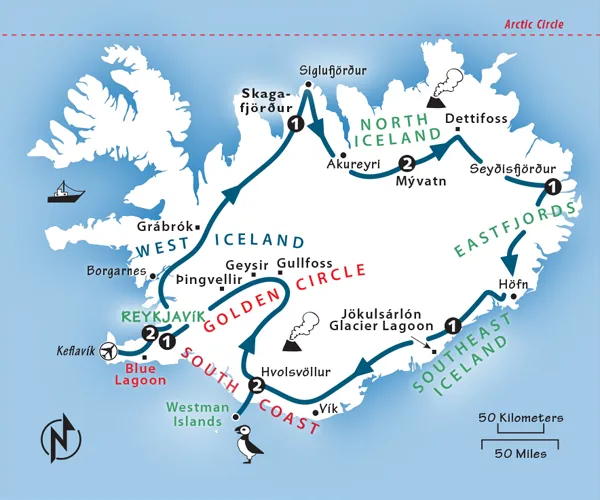
Landing in Iceland starts with northern charm and efficient travel paths. Here’s a breakdown of how to make the most of your first day:
Getting to the City
- Keflavík International Airport: I landed at Keflavík International Airport (KEF), a hub for international travelers. It’s about 45 minutes from Reykjavik, the dynamic capital of Iceland.
- Transportation to Reykjavik: Several options are available to reach the city. I found that buses and shuttles run regularly, though renting a car offers more freedom. Especially if you plan extensive exploration, having a car simplifies logistics and enhances flexibility.
- Reykjavik: Reykjavik’s vibrant culture, cuisine, and history welcomed me upon arrival. The city offers a rich glimpse into Icelandic lifestyle and traditions.
- Must-see attractions: Key attractions set the tone for exploring the city. Hallgrimskirkja church, an iconic structure, provides stunning views from its tower. The harbor and waterfront are perfect for casual walks while soaking in the local scene. Museums and galleries dotted around the city showcase impressive art and historical pieces.
- Blue Lagoon: A visit to the Blue Lagoon is essential, especially considering it’s just a 15-minute drive from the airport. This famous geothermal spa provides a relaxing start, helping to unwind from travel fatigue and immersing oneself in Iceland’s geothermal wonders.
By planning effectively, the first day in Reykjavik becomes a seamless blend of arrival logistics and initial explorations, setting a positive tone for the entire trip.
Day 2: The Golden Circle
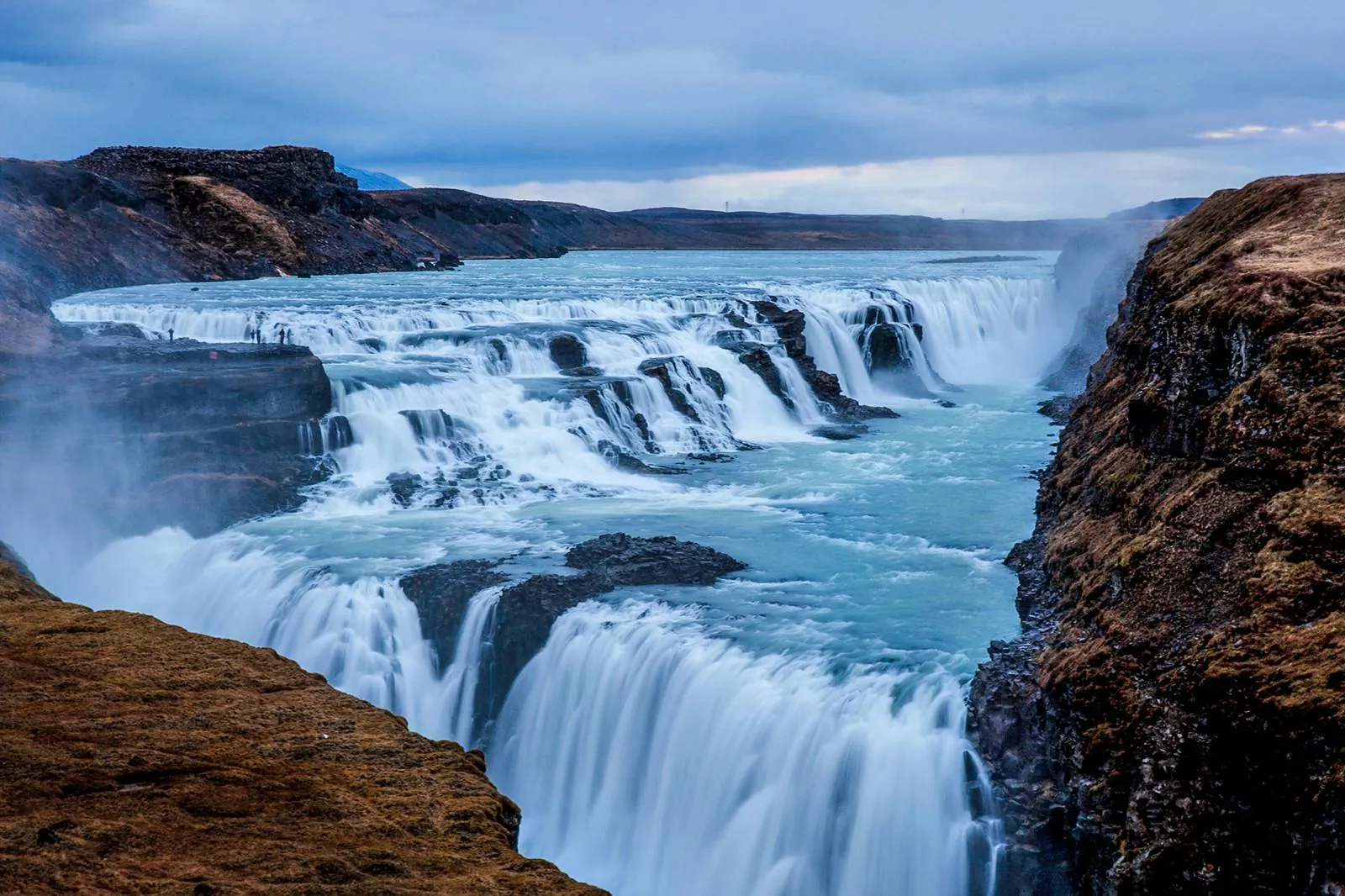
Exploring the Golden Circle on Day 2 offers a chance to see some of Iceland’s most iconic natural wonders. This day trip includes visits to Thingvellir National Park, Geysir Geothermal Area, and Gullfoss Waterfall.
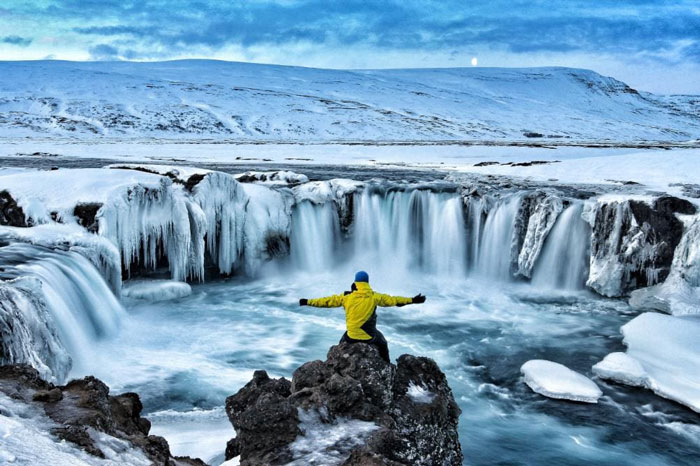
Thingvellir National Park
Thingvellir National Park, a UNESCO World Heritage Site, lies in a rift valley where the North American and Eurasian tectonic plates meet. It’s historically significant as the site of Iceland’s first parliament, established in 930 AD. The park showcases geological formations and impressive landscapes, making it a fascinating destination. I enjoyed walking along Almannagjá, the gorge formed by tectonic activity.
The park also offers diverse hiking trails that range from easy to challenging. Silfra, a unique diving spot, lets visitors swim between two continents in crystal clear glacial water. The Thingvallavatn Lake adds to the park’s scenic beauty, offering picturesque views and opportunities for fishing.
Geysir Geothermal Area
Next on the Golden Circle route, the Geysir Geothermal Area features an array of geothermal wonders. The standout attraction is Strokkur, a geyser erupting every 5-10 minutes, shooting hot water up to 20 meters high. The area also includes bubbling mud pots and steam vents, creating a surreal world.
A short walk from the parking area, this geothermal hotspot is easily accessible. I found the contrasting colors of the earth, minerals, and steam captivating. The visitor center provides information about geothermal activity and the area’s history, enhancing the experience.
Gullfoss Waterfall
Gullfoss Waterfall, a highlight of the Golden Circle, is a two-tiered waterfall with drops of 11 and 21 meters. Known for its powerful sound and scenic views, it draws visitors from around the world. Paths provide various viewpoints, each offering a unique perspective of the falls.
Being close to the edge gives a sense of the waterfall’s immense power. On windy days, the spray can soak onlookers, so waterproof clothing is advisable. Gullfoss is visually stunning throughout the year, with winter adding a spectacular icy world to the scene.
These three attractions, Thingvellir, Geysir, and Gullfoss, make the Golden Circle a must-visit day trip from Reykjavik, offering a full day of natural beauty and historical significance.
Day 3: South Coast Highlights
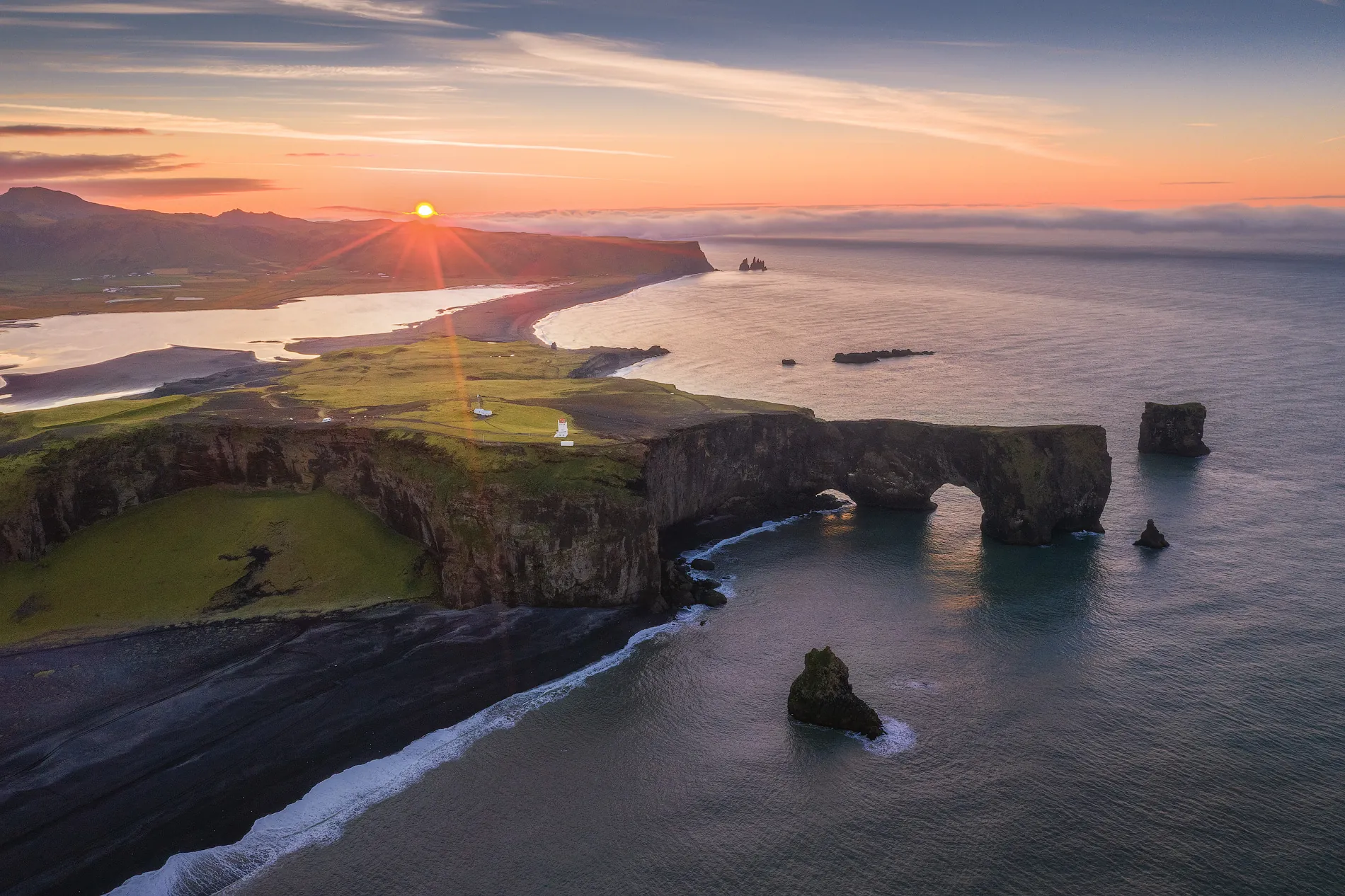
On Day 3 of my Iceland itinerary, the focus shifts to the stunning highlights of the South Coast, showcasing some of Iceland’s most iconic natural wonders.
Seljalandsfoss Waterfall
Seljalandsfoss Waterfall stands out among Iceland’s many impressive waterfalls, with a striking 60-meter drop. Located along Route 1, I found this waterfall easily accessible. A unique feature of Seljalandsfoss is the pathway that allows visitors to walk behind the waterfall during the summer months. The scene behind the falls offered a captivating view, with the sunlight filtering through the cascading water, creating a steamy mist that was simply mesmerizing. Visitors can climb a staircase on the side to get an alternate perspective of the falls.
Here’s a quick rundown for Seljalandsfoss:
- Height: Approximately 60 meters
- Special Feature: Pathway allowing visitors to walk behind the waterfall
- Accessibility: Easily reachable from Route 1
This waterfall is a must-see, particularly on clear days when the surrounding meadows burst into vibrant greens complemented by the occasional rainbow.
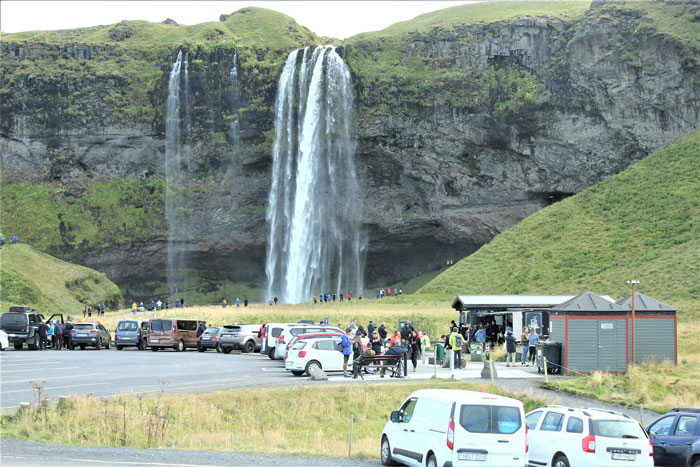
Skógafoss Waterfall
Skógafoss Waterfall, another gem along Iceland’s South Coast, is just a short drive from Seljalandsfoss. This waterfall, also about 60 meters tall, creates a thunderous sound as it splashes into the Skógá River below. The mist from the falling water often creates rainbows, adding to the picturesque surroundings. I was struck by its sheer volume and the ease with which visitors can get close to the cascade for a perfect photo opportunity. Those interested in a bit more adventure can climb a staircase alongside the waterfall that offers a panoramic view of both the falls and the expansive plains behind.
Key details for Skógafoss:
- Height: Approximately 60 meters
- Special Feature: Mist often produces beautiful rainbows
- Climbing Opportunity: Staircase to the top for panoramic views
Including Skógafoss in the itinerary enhanced my appreciation for Iceland’s powerful natural landscapes.
Reynisfjara Black Sand Beach
Reynisfjara Black Sand Beach offered a dramatic contrast to the lush greens and blues typically associated with Iceland. With its black volcanic sand, formidable basalt columns, and roaring Atlantic waves, this beach is undeniably unique. When I visited, the striking Reynisdrangar sea stacks stood majestically offshore, adding to the site’s allure. The powerful waves here are something to behold, making it essential to stay a safe distance from the water. Besides its natural beauty, Reynisfjara is often combined with visits to nearby attractions, including the village of Vik and the Dyrhólaey promontory.
Highlights of Reynisfjara Black Sand Beach:
- Sand Type: Black volcanic sand
- Notable Features: Basalt columns, Reynisdrangar sea stacks
- Safety Note: Strong waves—keep a safe distance from the shoreline
Exploring this beach provided a stark yet beautiful reminder of Iceland’s geological diversity, making it a highlight of my South Coast journey.
Day 4: Vatnajokull National Park

On Day 4, I’ll explore some of Iceland’s most breathtaking natural wonders, starting with Vatnajokull National Park.
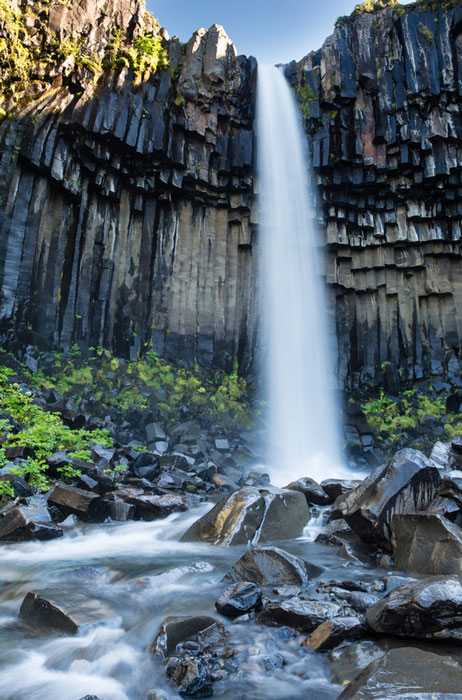
Jokulsarlon Glacier Lagoon
I’ll drive to Jokulsarlon Glacier Lagoon, where large blue icebergs float serenely. The lagoon, formed by melting ice from Vatnajokull Glacier, offers a unique sight. I’ll join a guided boat tour to get close to the icebergs, capturing stunning views and learning about their formation. Birdwatching enthusiasts can spot arctic terns and skuas. The tranquil atmosphere and striking scenery make this a must-visit.
Diamond Beach
Next, I’ll head to Diamond Beach, adjacent to Jokulsarlon Glacier Lagoon. Here, icebergs drift from the lagoon, washing up on the black sand beach. The contrast between the glittering ice and dark sand creates a mesmerizing view. I’ll wander along the beach, admiring the transparent ice chunks named for their diamond-like appearance. Photographers will find excellent opportunities for unique shots.
Skaftafell Nature Reserve
In the afternoon, I’ll visit Skaftafell Nature Reserve, part of Vatnajokull National Park. Skaftafell offers diverse landscapes, including lush vegetation and glacial vistas. I’ll hike to Svartifoss Waterfall, known for its hexagonal basalt columns. With well-marked trails, Skaftafell is perfect for hikers of all levels. The park also features diverse flora and fauna, enhancing the experience.
These destinations showcase the incredible beauty Iceland has to offer, ensuring an unforgettable day of exploration.
Day 5: East Fjords Adventure
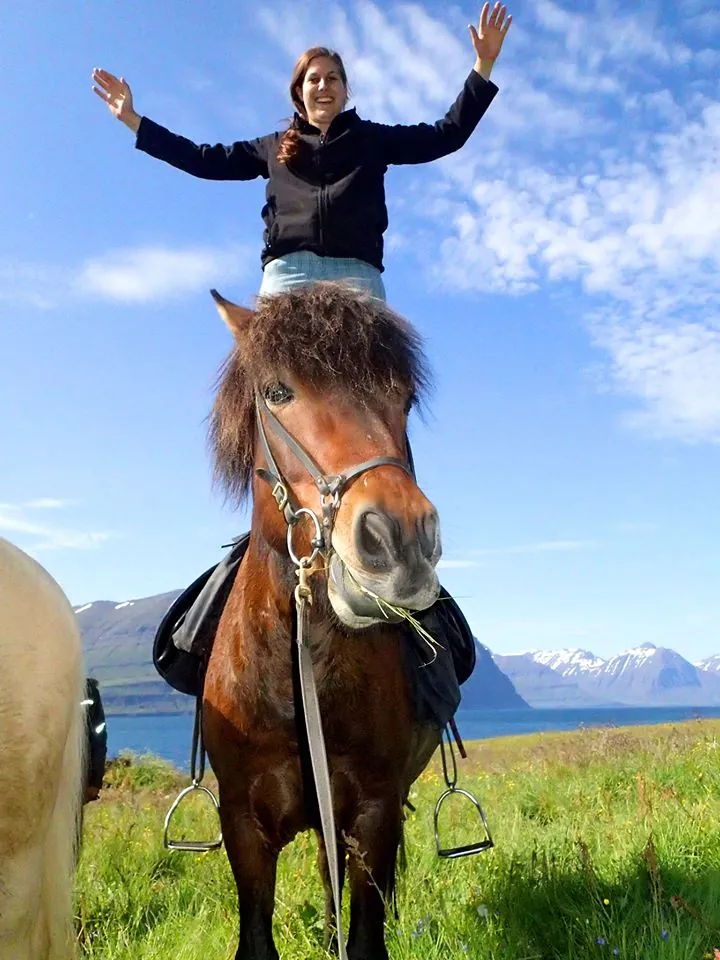
Faskrudsfjordur
On Day 5, explore the charming fjord town of Faskrudsfjordur. This picturesque town boasts scenic views and inviting hiking trails. In the morning, I recommend taking a short hike to the nearby waterfalls. These trails offer breathtaking vistas and an immersive experience in nature.
Walking through the town’s charming streets, you’ll notice historical buildings and a strong link to French fishermen, who frequented the area in the past. For those interested in history, visit the French Hospital Museum, which provides insight into this unique part of Faskrudsfjordur’s heritage. There are also quaint cafes and shops where you can grab a quick bite or a souvenir.
In Faskrudsfjordur, the blend of natural beauty and cultural history creates an enriching start to the day. Whether hiking or exploring, the town has something for everyone, making it a perfect first stop on your East Fjords adventure.
Seydisfjordur
After Faskrudsfjordur, head to Seydisfjordur, a town known for its rich history and vibrant culture. Arriving in the afternoon, you’ll be greeted by stunning views of the fjord and the town’s colorful buildings. Start by visiting the Seydisfjordur Church, a picturesque blue structure that stands out against the natural backdrop.
For art enthusiasts, the town’s art scene is a must-see. Numerous galleries feature works by local artists, and you can often find outdoor art installations throughout the town. Exploring these galleries gives you a sense of the creative spirit that thrives in Seydisfjordur.
Strolling through the town, you’ll encounter a variety of shops and cafes. These spots offer a chance to experience local cuisine and unique Icelandic crafts. As evening approaches, either stay in Seydisfjordur or drive to nearby Egilsstaðir for accommodations. This plan ensures you’re well-rested and ready for the next day’s adventures.
In Seydisfjordur, the blend of culture, history, and natural beauty offers a memorable experience, making the East Fjords a highlight of any Iceland itinerary.
Day 6: Myvatn and North Iceland
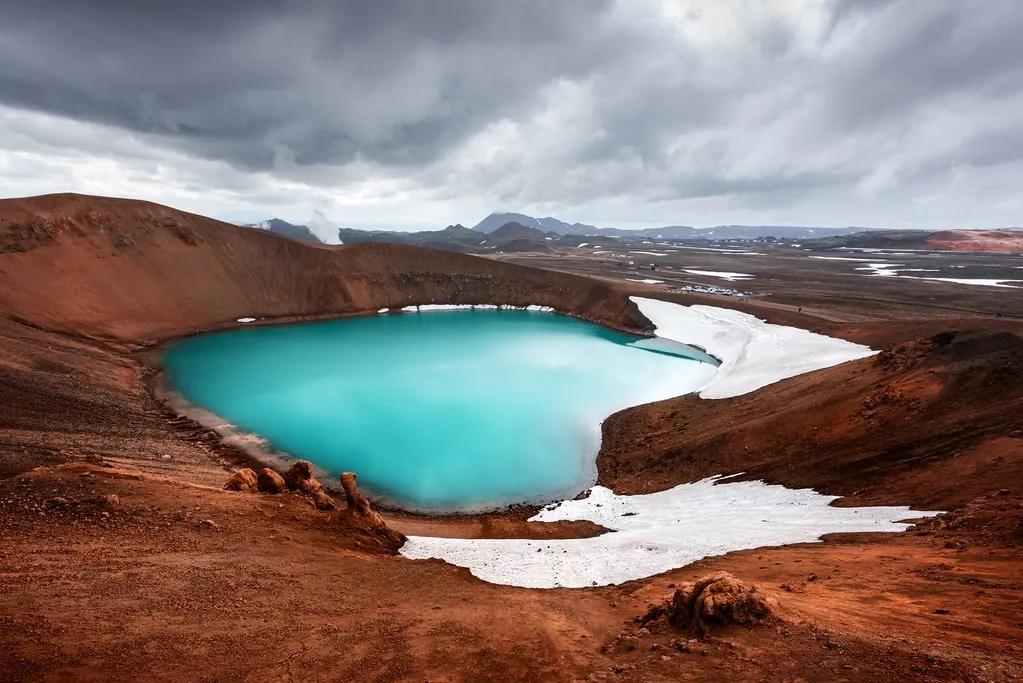
Day 6 immerses you in the beauty of North Iceland. The highlights include Lake Myvatn, Dettifoss Waterfall, and Godafoss Waterfall.
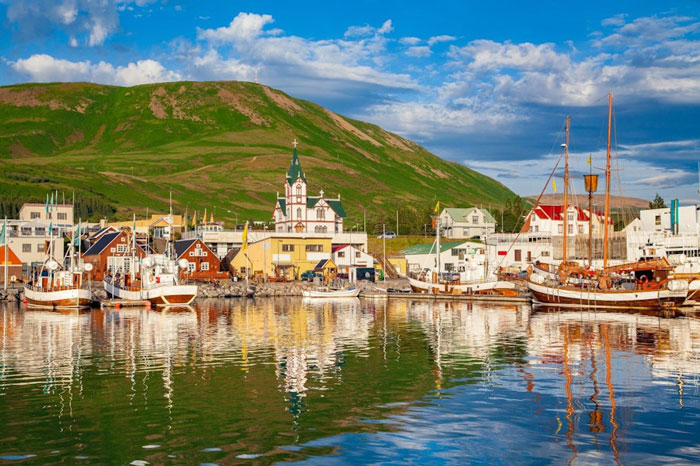
Lake Myvatn
Lake Myvatn is famous for its natural beauty and rich birdlife. Situated in a geologically active area, the lake is surrounded by unique geological formations. The Dimmuborgir rock formations are a prime example, with their twisted lava structures and eerie world. These formations are remnants of ancient volcanic eruptions, creating a surreal, almost otherworldly atmosphere.
Aside from the geological features, the lake also attracts various bird species, especially in the summer months. Birdwatchers often find species like the Barrow’s Goldeneye and the Great Northern Diver here. The nearby Myvatn Nature Baths offer a relaxing experience with their geothermal waters, often considered a quieter alternative to the Blue Lagoon.
Dettifoss Waterfall
Dettifoss, Europe’s most powerful waterfall, is a must-see near Lake Myvatn. The waterfall’s sheer force is astounding, with water crashing down a height of 144 feet. Located in Vatnajokull National Park, Dettifoss is part of the glacial river Jokulsa a Fjollum, adding to its awe-inspiring presence.
The scenic surroundings enhance its appeal, featuring rugged terrain and lush greenery. There are two main viewpoints: the west and east sides. The west side offers easy access and dramatic views from a safe distance, while the east side brings you closer to the action but involves a more challenging hike. Both perspectives offer unforgettable sights and sounds, making Dettifoss a highlight of any North Iceland itinerary.
Godafoss Waterfall
Godafoss Waterfall, known as the “Waterfall of the Gods,” adds a touch of mythology to your trip. This waterfall is significant both in size and beauty, spanning nearly 100 feet in width and cascading 39 feet into a turquoise pool. According to legend, in 1000 AD, upon adopting Christianity, the Icelandic chieftain Thorgeir Ljosvetningagodi threw his pagan idols into the waterfall, earning it its name.
The surrounding area is easily accessible from the Ring Road, making it a convenient stop. Viewing platforms on both sides of the waterfall provide different angles, with the west side offering panoramic views and the east side providing closer proximity. This mix of historical significance and natural beauty makes Godafoss a captivating destination.
Day 7: Return to Reykjavik via West Iceland
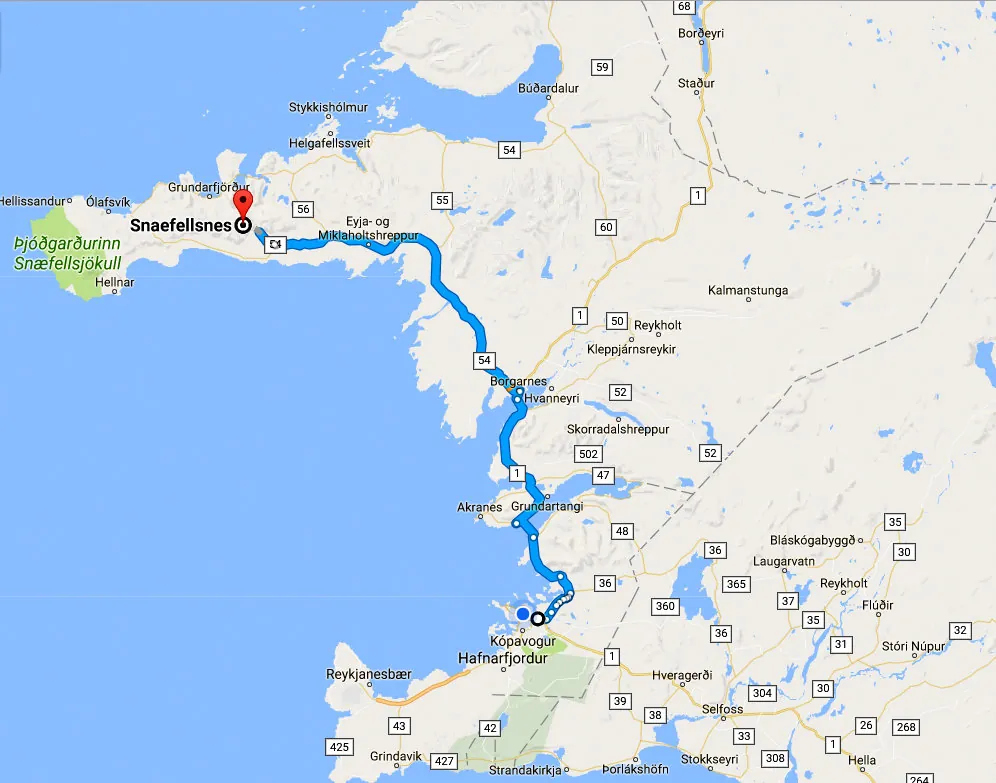
The final leg of the journey passes through the stunning landscapes of West Iceland, providing opportunities to explore unique natural sites like Hraunfossar and Barnafoss Waterfalls, Deildartunguhver Hot Spring, and the charming town of Borgarnes.
Hraunfossar and Barnafoss Waterfalls
Hraunfossar, also known as the “Lava Falls,” is a mesmerizing collection of hundreds of small streams cascading over a distance of nearly 900 meters. Formed by rivulets seeping through the Hallmundarhraun lava field, these waterfalls create an ethereal scene. The clear blue waters trickling over dark lava rocks provide photographers with an ideal subject. Visitors often take leisurely walks along the pathways, enjoying views from various angles.
Not far from Hraunfossar, visitors find Barnafoss, or “Children’s Falls,” recognized for its vigorous torrents. Unlike Hraunfossar’s serene setting, Barnafoss involves gushing waters cutting through a narrow, rocky gorge. A natural lava bridge once spanned these falls, adding to the mystical aura. Legends say children fell into the falls, giving rise to the name and captivating stories. Well-maintained trails and viewing platforms enable safe and thrilling exploration.
Deildartunguhver Hot Spring
Deildartunguhver, located in West Iceland, holds the title for Europe’s most powerful hot spring. With water temperatures reaching up to 212°F (100°C), this geothermal wonder generates over 180 liters per second. The copious steam and bubbling hot water make it a striking sight. Facilities in the vicinity ensure safe viewing, while also serving as an energy source for nearby towns.
Visitors exploring Deildartunguhver often immerse themselves in the relaxing Krauma Baths, which harness the spring’s geothermal energy. The blend of hot and cold water in these baths provides a unique experience, with steam rooms and relaxation areas complementing the visit. Local legends also suggest the hot spring possesses health benefits, increasing its appeal.
Borgarnes
Borgarnes, a quaint town in West Iceland, offers a delightful pause on the return journey to Reykjavik. With a population of around 1,800, it strikes a balance between modern amenities and small-town charm. Spectacular views of the Hafnarfjall mountain and Borgarfjordur bay make it visually appealing.
The Settlement Center, a popular attraction in Borgarnes, explores Iceland’s early settler history through interactive exhibits. Visitors learn about the Sagas and the founding of the country. Fine dining and cozy cafés provide excellent opportunities to savor Icelandic cuisine, making it a pleasant stop before continuing to Reykjavik.
Conclusion
My 7-day itinerary in Iceland offers a diverse and unforgettable experience. From the iconic Golden Circle to the serene East Fjords every day brings a new adventure. The natural wonders like Jokulsarlon Glacier Lagoon and Dettifoss Waterfall are awe-inspiring.
Exploring Reykjavik and the unique sites in West Iceland adds a perfect blend of culture and nature. This journey through Iceland’s stunning landscapes and vibrant towns will leave you with lasting memories and a deeper appreciation for this incredible country.
Frequently Asked Questions
What is the Golden Circle in Iceland?
The Golden Circle is a popular tourist route in Iceland that includes three major attractions: Thingvellir National Park, Geysir Geothermal Area, and Gullfoss Waterfall.
What can I expect to see along the South Coast of Iceland?
The South Coast features stunning landscapes including waterfalls like Seljalandsfoss and Skogafoss, black sand beaches, and impressive glaciers.
What is unique about Jokulsarlon Glacier Lagoon and Diamond Beach?
Jokulsarlon Glacier Lagoon is known for its floating icebergs, while Diamond Beach shines with ice chunks that have washed ashore, creating a glittering spectacle.
What makes the East Fjords worth visiting?
The East Fjords offer scenic fjords, historical sites, waterfalls, and charming towns like Faskrudsfjordur and Seydisfjordur, known for its art scene and vibrant culture.
What are the main attractions in North Iceland?
North Iceland highlights include Lake Myvatn, known for its geothermal activity, and stunning waterfalls like Dettifoss and Godafoss.
What can I explore in West Iceland on the way back to Reykjavik?
West Iceland features unique natural sites like Hraunfossar and Barnafoss Waterfalls, Deildartunguhver Hot Spring, and the charming town of Borgarnes.
What are Hraunfossar and Barnafoss Waterfalls?
Hraunfossar, or “Lava Falls,” offers a mesmerizing scene of cascading streams over lava rocks, while Barnafoss, or “Children’s Falls,” presents vigorous torrents and mystical legends.
Why is Deildartunguhver Hot Spring significant?
Deildartunguhver is Europe’s most powerful hot spring, showcasing bubbling hot water that provides energy for nearby towns.
What can I do in Borgarnes?
Borgarnes is a quaint town offering modern amenities and attractions like the Settlement Center, which explores Iceland’s early settler history, and opportunities to savor Icelandic cuisine.

